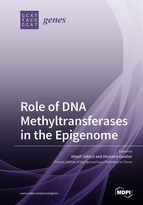Role of DNA Methyltransferases in the Epigenome
A special issue of Genes (ISSN 2073-4425). This special issue belongs to the section "Molecular Genetics and Genomics".
Deadline for manuscript submissions: closed (16 November 2018) | Viewed by 90144
Special Issue Editors
Interests: DNA methyltransferases; DNA methylation; protein methyltransferases; protein methylation; reading domains; molecular epigenetics; synthetic biology; molecular enzymology
Special Issues, Collections and Topics in MDPI journals
Interests: cell culture; gene expression; DNA sequencing; genomics; gene regulation; next generation sequencing; epigenetics; regulation of gene expression; transcription; transcriptional regulation; DNA methylation; gene expression and chromatin biology; chromatin; methylation; histone modification; epigenomics; ChIP-sequencing; chromatin remodeling; chromatin structure; chromatin biology; embryonic stem cell culture and differentiation; enhancer regulation
Special Issues, Collections and Topics in MDPI journals
Special Issue Information
Dear Colleagues,
DNA methylation, a modification found in most species, regulates chromatin functions in conjunction with other epigenome modifications, such as histone post-translational modifications and non-coding RNAs. In mammals, DNA methylation has an essential role in development by orchestrating the generation and maintenance of the phenotypic diversity of human cell types. Recent years have brought spectacular advances in our understanding of the mechanism, function and regulation of DNA methyltransferases through their interaction with other epigenome modifications, chromatin factors and post-translational modifications. This Special Issue of Genes will cover all these aspects of epigenome regulation by DNA methyltransferases. Manuscripts describing the targeting and regulation of DNA methyltransferases by interacting factors, DNA binding proteins, non-coding RNAs, post-translational modifications and by conformational changes are within the scope of this issue. Additionally, biochemical and genetic studies addressing the effects of DNA methyltransferases on cellular differentiation and the development of diseases, as well as studies investigating the effects of DNA methyltransferases on other marks of the epigenome network are highly welcome.
Prof. Dr. Albert Jeltsch and Prof. Dr. Humaira Gowher
Guest Editors
Manuscript Submission Information
Manuscripts should be submitted online at www.mdpi.com by registering and logging in to this website. Once you are registered, click here to go to the submission form. Manuscripts can be submitted until the deadline. All submissions that pass pre-check are peer-reviewed. Accepted papers will be published continuously in the journal (as soon as accepted) and will be listed together on the special issue website. Research articles, review articles as well as short communications are invited. For planned papers, a title and short abstract (about 100 words) can be sent to the Editorial Office for announcement on this website.
Submitted manuscripts should not have been published previously, nor be under consideration for publication elsewhere (except conference proceedings papers). All manuscripts are thoroughly refereed through a single-blind peer-review process. A guide for authors and other relevant information for submission of manuscripts is available on the Instructions for Authors page. Genes is an international peer-reviewed open access monthly journal published by MDPI.
Please visit the Instructions for Authors page before submitting a manuscript. The Article Processing Charge (APC) for publication in this open access journal is 2600 CHF (Swiss Francs). Submitted papers should be well formatted and use good English. Authors may use MDPI's English editing service prior to publication or during author revisions.
Keywords
- DNA methyltransferase function
- DNA methyltransferase mechanism
- DNA methyltransferase regulation
- DNA methyltransferase structure
- DNMT1
- DNMT3A
- DNMT3B
- DNA Methylation








